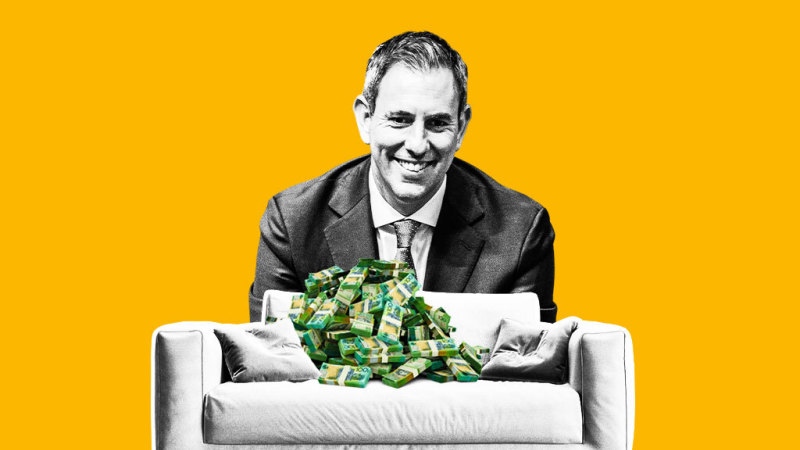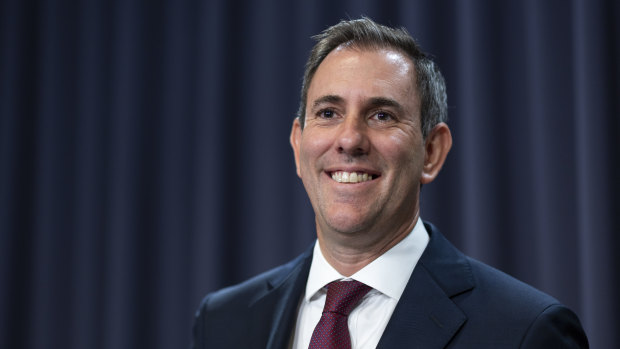The $100b Jim found down the back of the couch

Save articles for later
Add articles to your saved list and come back to them any time.
In the space of 18 months, Treasurer Jim Chalmers has found the best part of $100 billion down the back of the budget lounge.
That $100 billion is the difference between what his predecessor, Josh Frydenberg, was expecting to collect in tax from working Australians between 2023-24 and 2025-26, and what Chalmers is now forecasting to trouser from them.
Cash down the back of the couch: a surge in tax revenue has helped Jim Chalmers.Credit: Alex Ellinghausen
Super-strong jobs growth (an extra 620,000 people in work since last year’s election), record-high workforce participation, bracket creep and a lift in wage growth have all delivered this injection to the nation’s bottom line.
In the current financial year alone, personal tax collections are forecast to be $39.3 billion higher than Frydenberg was expecting.
Over in the budget dust buster, a spare $60 billion has been sucked up from the nation’s companies – principally the miners and banks.
These two revenue gifts, and the fact that this government has decided to ferret most of it away rather than spend it, account for why Chalmers will probably be the first treasurer since Peter Costello to deliver consecutive budget surpluses.
But the sheer amount of tax being collected – a reflection of a stronger economy and higher inflation – is also putting pressure on Chalmers and Prime Minister Anthony Albanese.
The government’s tax take is now forecast to reach 23.7 per cent of GDP this financial year. The last time it was that high was under Costello and John Howard in 2007-08.
Labor then bemoaned the “high-taxing Howard-Costello government”. Now it’s in the same boat.
If not for the contentious stage 3 tax cuts due to start flowing from July 1, the Albanese-Chalmers government would have the tax share at 23.9 per cent – perilously close to the record level set by Howard and Costello in the early noughties.
Much of this extra tax is in effect a payback for all the financial support lavished on workers and businesses by the Morrison government and the Reserve Bank during the COVID-19 pandemic. It’s the payback needed to repair the budget.
But as the Reserve Bank has noted, the lift in tax being paid is one of the reasons consumers are struggling on top of high inflation and increasing interest rates.
That’s not to say it’s all beer and skittles in Treasury, with costs jumping in areas beyond its control.
The federal contribution to private schools, for instance, is up $2 billion over the next four years, largely because parents are choosing them over the public sector.
The cost of the childcare subsidy has grown by $2.2 billion over the next four years, in part due to stronger demand but also because providers have pushed up fees.
The largest increase has been the expected interest bill on outstanding government debt, which has climbed by $3.6 billion since the May budget.
It’s not that long ago that the adherents of modern monetary theory were advocating larger deficits to get the economy growing.
As Chalmers noted, the government is avoiding $145 billion in interest costs out to 2033-34 because of its smaller deficits and reduced debt levels.
Chalmers and Finance Minister Katy Gallagher have held their nerve in the face of strident calls for more spending to deal with inflation. The rewards for that diligence may not be far away.
If, and that’s a big if, events play out as expected, wages will be outpacing inflation by early 2024. Chalmers will be using next year’s budget to reveal another surplus and better financial days ahead. Tax cuts should be hitting bank accounts from the middle of the year. And the Reserve Bank may have sliced the official cash rate by next Christmas.
That’s a good set of numbers for any government facing an election in 2025.
Cut through the noise of federal politics with news, views and expert analysis from Jacqueline Maley. Subscribers can sign up to our weekly Inside Politics newsletter here.
Most Viewed in Politics
From our partners
Source: Read Full Article
